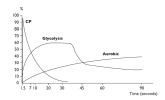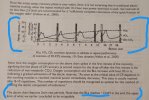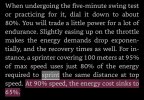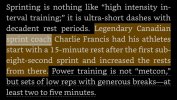Paotle
Level 4 Valued Member
Hi everyone,
It is obvious that training of <4 seconds mainly uses PCr pathway which is alactic. However, my past experience as a sprinter and lactate testing done on me at the time showed that even a small number of intervals with very short sprints (3-5 seconds) with 3-5' rests caused high lactate peaks >20mmol /L.
I came across this post (see below) from Hakan Andersson an elite sprinting coach who shows that 3*4*60m/3'/10' caused a lactate surge similar to what I had experienced on efforts of 5-6 seconds.
Two reminders:
1. The (critical) lactate threshold is at 4mmol/L. The data shown here on "alactic sprints" with nearly complete rest are a massive lactate production (20mmol/L) similar to very high intensity intervals of 4 minutes.
2. these workouts are supposed to be much less lactic than what the Strongfirst system advocates.
Although these are good level sprinters who necessarily produce a lot of lactate, this still shows that there is no such thing as alactic effort and that even a few short (<7 seconds) repeats with long rest produce massive lactate.
Have some of you done lactate testing during A+A? How were your datas?
Best,
Paotle
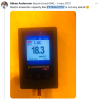

It is obvious that training of <4 seconds mainly uses PCr pathway which is alactic. However, my past experience as a sprinter and lactate testing done on me at the time showed that even a small number of intervals with very short sprints (3-5 seconds) with 3-5' rests caused high lactate peaks >20mmol /L.
I came across this post (see below) from Hakan Andersson an elite sprinting coach who shows that 3*4*60m/3'/10' caused a lactate surge similar to what I had experienced on efforts of 5-6 seconds.
Two reminders:
1. The (critical) lactate threshold is at 4mmol/L. The data shown here on "alactic sprints" with nearly complete rest are a massive lactate production (20mmol/L) similar to very high intensity intervals of 4 minutes.
2. these workouts are supposed to be much less lactic than what the Strongfirst system advocates.
Although these are good level sprinters who necessarily produce a lot of lactate, this still shows that there is no such thing as alactic effort and that even a few short (<7 seconds) repeats with long rest produce massive lactate.
Have some of you done lactate testing during A+A? How were your datas?
Best,
Paotle




